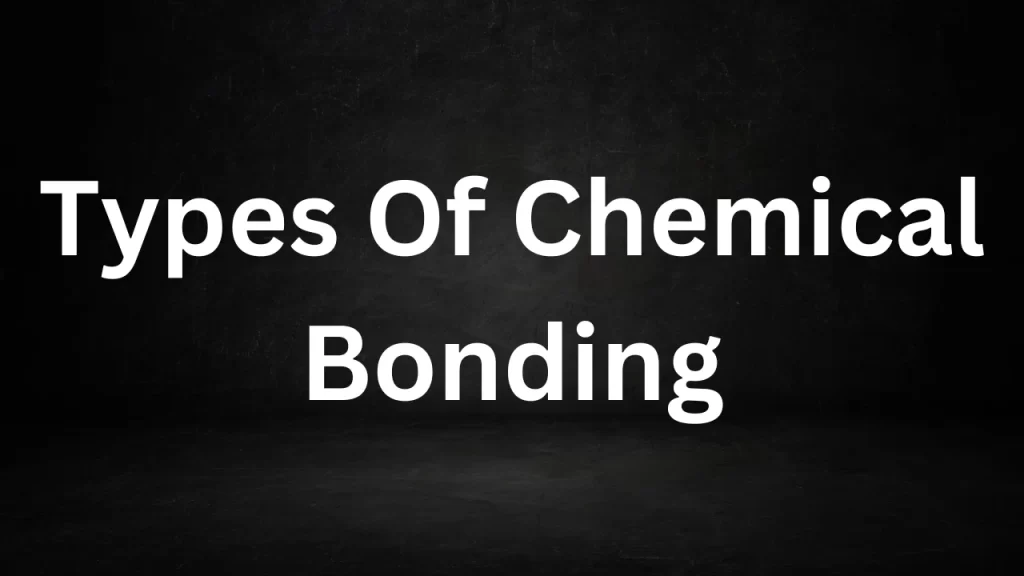Tag: Types Of Chemical Bonding
Types Of Chemical Bonding
Types Of Chemical Bonding: Chemical bonding is a fundamental concept in chemistry that helps us understand how atoms combine to form molecules and compounds.
It governs the physical and chemical properties of matter and is the basis for the diversity of substances we encounter in our daily lives. In this article, we will delve into the different types of chemical bonding and their significance in the world of chemistry.

Types Of Chemical Bonding
1. Ionic Bonding
Ionic bonding occurs when one or more electrons are transferred from one atom to another, resulting in the formation of ions with opposite charges. This type of bonding typically occurs between metals and nonmetals. The metal loses electrons to become a positively charged cation, while the nonmetal gains those electrons to become a negatively charged anion. The strong electrostatic attraction between these oppositely charged ions holds them together in ionic compounds.
Significance: Ionic compounds, such as table salt (sodium chloride, NaCl) and calcium carbonate (CaCO3), are vital in various applications, including in the food industry, medicine, and the production of ceramics and glass.
2. Covalent Bonding
Covalent bonding results from the sharing of electrons between atoms, typically between nonmetals. In a covalent bond, atoms share one or more pairs of electrons, resulting in the formation of molecules. This type of bonding is characterized by the strong attraction between the shared electrons and the positively charged nuclei of the atoms involved.
Significance: Covalent compounds, like water (H2O) and methane (CH4), are widespread in nature and have diverse uses, from serving as essential compounds for life to forming the basis of many organic chemicals.
3. Metallic Bonding
Metallic bonding occurs in metals, where atoms within a solid lattice structure share their valence electrons freely. This sharing of electrons creates a “sea of electrons” that moves throughout the structure, giving metals their unique properties such as electrical conductivity and malleability.
Significance: Metallic bonds are crucial in the construction of electrical wires, the production of structural materials, and the formation of alloys, which have applications in aerospace, construction, and manufacturing.
4. Hydrogen Bonding
Hydrogen bonding is a special type of dipole-dipole interaction that occurs when a hydrogen atom is covalently bonded to a highly electronegative atom (usually oxygen, nitrogen, or fluorine) and is attracted to another electronegative atom in a nearby molecule. This bond is responsible for the unique properties of water, such as its high boiling point and surface tension.
Significance: Hydrogen bonding is essential in biology, contributing to the structure of DNA, the folding of proteins, and the properties of water that support life.
5. Van der Waals Forces
Van der Waals forces, also known as London dispersion forces and dipole-dipole interactions, are relatively weak attractions that exist between all molecules, regardless of their polarity. These forces are caused by temporary fluctuations in electron distribution within molecules, creating temporary positive and negative charges that attract nearby molecules.
Significance: Van der Waals forces play a significant role in the behavior of gases, the condensation of liquids, and the adsorption of molecules onto surfaces, influencing phenomena like adhesion and cohesion.
6. Coordinate Covalent Bonding
In coordinate covalent bonding, also known as dative bonding, one atom donates a pair of electrons to be shared in a covalent bond with another atom. This type of bonding is commonly found in complex ions and coordination compounds.
Significance: Coordinate covalent bonds are essential in the formation of metal complexes, which are widely used in catalysis, as pigments, and in the study of coordination chemistry.
Understanding the various types of chemical bonding is fundamental to comprehending the behavior of matter, the properties of substances, and the countless applications of chemistry in our daily lives.
Read More
- Chemistry In Everyday Life
- Energy Stored In A Capacitor
- Compound Lenses Thin Lenses In Contact
- 12th Class English Book Question Answer Pdf Download
Frequently Asked Question (FAQs) Types Of Chemical Bonding
1. What is chemical bonding?
Chemical bonding is the process by which atoms combine to form molecules or compounds. It involves the sharing or transfer of electrons between atoms to achieve a stable electronic configuration.
2. What are the main types of chemical bonding?
The main types of chemical bonding are ionic bonding, covalent bonding, metallic bonding, hydrogen bonding, Van der Waals forces, and coordinate covalent bonding.
3. What is ionic bonding, and how does it work?
Ionic bonding occurs when one atom transfers electrons to another, resulting in the formation of ions with opposite charges. The electrostatic attraction between these oppositely charged ions holds them together in an ionic compound.
4. Can you provide examples of substances with ionic bonding?
Examples of substances with ionic bonding include table salt (sodium chloride, NaCl), calcium carbonate (CaCO3), and magnesium oxide (MgO).
5. What is covalent bonding, and how does it differ from ionic bonding?
Covalent bonding involves the sharing of electrons between atoms, typically between nonmetals. In contrast to ionic bonding, where electrons are transferred, covalent bonds result from the mutual attraction between shared electrons and the positively charged nuclei of the atoms involved.